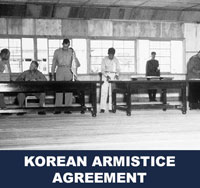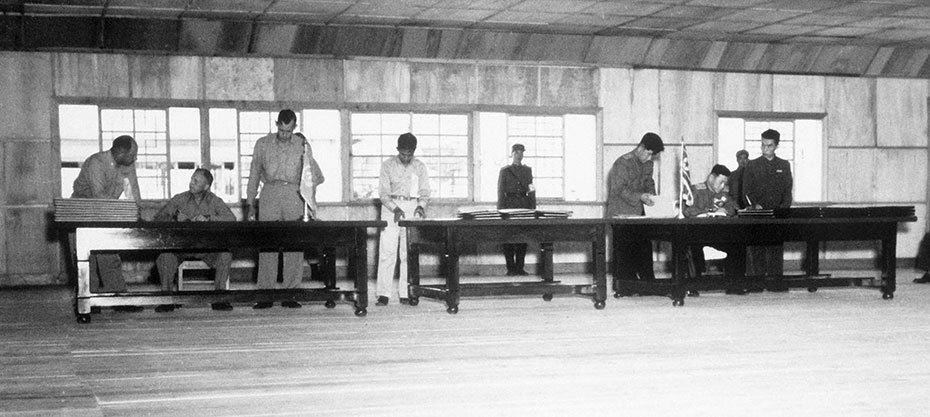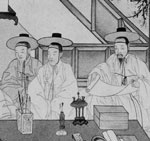Taekwondo 태권도Taekwondo Preschool
Joseon was a Korean state founded by Taejo Yi Seong-gye that lasted for approximately five centuries, from July 1392 to October 1897. It was founded following the aftermath of the overthrow of the Goryeo Dynasty in what is today the city of Kaesong. Early on, Korea was retitled and the capital was relocated to modern-day Seoul. View Joseon Era 조선 »

Korean Armistice Agreement
The division of Korea into South Korea and North Korea was the result of the 1945 Allied victory in World War II, ending the Empire of Japan's 35-year colonial rule of Korea by General Order No. 1.
The Korean Armistice Agreement is the armistice which ended the Korean War. It was signed by U.S. Army Lieutenant General William Harrison, Jr. representing the United Nations Command (UNC), North Korean General Nam Il representing the North Korean People's Army, and the Chinese People’s Volunteer Army. The armistice was signed on July 27, 1953, and was designed to "insure a complete cessation of hostilities and of all acts of armed force in Korea until a final peaceful settlement is achieved." No "final peaceful settlement" has been achieved yet. The signed armistice established the Korean Demilitarized Zone (de facto a new border between the two nations), put into force a cease-fire, and finalized repatriation of prisoners of war. The Demilitarized Zone runs not far from the 38th parallel which separated Northern and Southern Koreas before the war.

UN delegate Lieut. Gen. William K. Harrison, Jr. (seated left), and Korean People’s Army and Chinese People’s Volunteers delegate Gen. Nam Il (seated right) signing the Korean War armistice agreement at P’anmunjŏm, Korea, July 27, 1953.
Armistice (July 1953 - November 1954)
The on-again, off-again armistice negotiations continued for two years, first at Kaesong (southern North Korea), then relocated at Panmunjom (bordering the Koreas). A major, problematic negotiation point was prisoner of war (POW) repatriation. The PVA, KPA, and UN Command could not agree on a system of repatriation because many PVA and KPA soldiers refused to be repatriated back to the north, which was unacceptable to the Chinese and North Koreans. In the final armistice agreement, signed on 27 July 1953, a Neutral Nations Repatriation Commission, under the Chairman Indian General K. S. Thimayya, was set up to handle the matter.
In 1952, the US elected a new president, and on 29 November 1952, the president-elect, Dwight D. Eisenhower, went to Korea to learn what might end the Korean War. With the United Nations' acceptance of India's proposed Korean War armistice, the KPA, the PVA, and the UN Command ceased fire with the battle line approximately at the 38th parallel. Upon agreeing to the armistice, the belligerents established the Korean Demilitarized Zone (DMZ), which has since been patrolled by the KPA and ROKA, US, and Joint UN Commands.
The Demilitarized Zone runs northeast of the 38th parallel; to the south, it travels west. The old Korean capital city of Kaesong, site of the armistice negotiations, originally lay in the pre-war ROK, but now is in the DPRK. The United Nations Command, supported by the United States, the North Korean People's Army, and the Chinese People's Volunteers, signed the Armistice Agreement on 27 July 1953 to end the fighting. The Armistice also called upon the governments of South Korea, North Korea, China and the United States to participate in continued peace talks. The war is considered to have ended at this point, even though there was no peace treaty. North Korea nevertheless claims that it won the Korean War.
After the war, Operation Glory (July–November 1954) was conducted to allow combatant countries to exchange their dead. The remains of 4,167 US Army and US Marine Corps dead were exchanged for 13,528 KPA and PVA dead, and 546 civilians dead in UN prisoner-of-war camps were delivered to the ROK government. After Operation Glory, 416 Korean War unknown soldiers were buried in the National Memorial Cemetery of the Pacific (The Punchbowl), on the island of Oahu, Hawaii. Defense Prisoner of War/Missing Personnel Office (DPMO) records indicate that the PRC and the DPRK transmitted 1,394 names, of which 858 were correct. From 4,167 containers of returned remains, forensic examination identified 4,219 individuals. Of these, 2,944 were identified as American, and all but 416 were identified by name. From 1996 to 2006, the DPRK recovered 220 remains near the Sino-Korean border.

Korea ( 한국 )
Korea ( 한국 ) called Hanguk in South Korea and Chosŏn in North Korea, is an East Asian territory that is divided into two distinct sovereign states, North Korea and South Korea. Located on the Korean Peninsula, Korea is bordered by China to the northwest and Russia to the northeast. It is separated from Japan to the east by the Korea Strait and the Sea of Japan (East Sea). For more information View Korea ( 한국 ) »
RESOURCES
This article uses material from the Wikipedia articles "Korean Armistice Agreement" and "Korean War", which is released under the Creative Commons Attribution-Share-Alike License 3.0.









